| dc.description.abstract | A systematic investigation was started within the Texas Utilities Generating Company Power station feedwater pump systems due to unsatisfactory unit availability, frequent equipment breakdown, high maintenance costs, and high replacement parts costs. This action was greatly encouraged by successful corrective actions taken by other utilities [1,2,3], results of failure surveys across the U.S.A [4,5), and systematic long range research and development, field testing and troubleshooting by the authors, and close cooperation and exchange of ideas and results with at least on oil company [6]. A total of 36 pumps was modified in the Texas Utilities system as described in this paper. This included 16 boiler feed pumps (BFP), 7 high pressure (HP) booster pumps, 6 low pressure (LP) booster pumps, and 7 other pump applications. The operating behavior of all pumps improved exactly as expected, with the exception of one high pressure booster pump, which is described as a special case, with the emphasis on the importance or re-assembly and maintenance procedures. The power plants and the type of pumps involved in this investigation and corrective design changes are reflected in Table1. Basically, we have to distinguish between multistage boiler feed pumps (or process pumps) and single stage double suction booster pumps (or condensate, ash sluice, circulating, cooling water, etc) because the same hydraulically induced instability problem manifests itself in a very different way through the type of vibrations we experience and measure. Single stage pumps usually show a herby axial vibration mode of the rotor, while multistage pumps show radial response, although the origin of the excitation is the same. | en |


